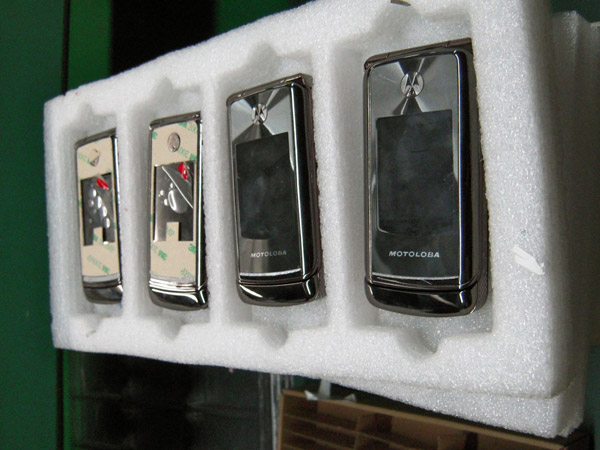The various branches of Shenzhen’s mobile phone industry
Shenzhen speed
In my imagination electronics were produced by heavy machinery ever since the industrial revolution. In large sterile factory halls machines would reproduce themselves creating even more powerful and smarter devices as technology develops. In reality the picture is quite different, at least in mobile phone factories in China. If you replace the heavy machinery with frail young migrant workers and add a little dust and the smell of instant noodles to the scenery it becomes a better representation of how mobile phones are being produced in China. As Shenzhen houses various branches of the mobile phone industry I tried to piece together the overall picture. From meetings with factory owners and startup entrepreneurs to visiting the production halls and workers residences, they all provided an idea of the connection between the little branches of the industry. I discovered that aside from the shiny and new there is also a large market for secondhand electronics. By living with a local reseller in the heart of the secondhand mobile phone scene in Shenzhen I experienced the ins and outs of their daily life where most days go by monotonously. Still I can say that this is not a dull profession. I was at the right place and time to experience the commotion law enforcers caused in their attempt to roll up not so legal practices in electronics.
Before describing my visit, first a few facts about Shenzhen to gain a better understanding of the city and its context. The city is located in the south of China in the Guangdong province, immediately north of Hong Kong. It was arguably China’s most successful Special Economic Zone. Up to the late 1970s Shenzhen was a small village until Chinese and foreign nationals invested enormous amounts of money in the economy. It grew into the third busiest container port in China after Shanghai and Hong Kong housing the headquarters of numerous technology companies. The phenomenal pace at which the city developed is now referred to as ‘Shenzhen speed’.1 Because of the booming economy young people from all regions of China move here to look for a job or start their own business. Many of people get into the mobile phone business, either manufacturing or selling. Some work in factories or repair old cell phones for reselling. With some investment money other entrepreneurs start their own company offering their own collection of new cell phones. Most of the migrant workers at the production lines are young women, as they are considered to be better suited for detail-oriented work. In some factories male workers from specific Chinese provinces are even avoided as they are labeled troublemakers.2
One of the things that I wanted to do in Shenzhen aside from sightseeing was to visit a factory where they produce electronics. I quickly found out that factories in general are not too eager to let in nosy people, particularly ones asking questions and taking pictures. Aside from the sometimes not-so-comfortable working circumstances in the factories, they’re also dealing with product information that should be kept top secret due to the fierce competition. Not one of my emails requesting an interview and a tour of the factory received a reply. Maybe it was because the people didn’t understand English or perhaps because they just didn’t want to. I tried a different approach and after contacting some acquaintances they were able to pull strings and arrange a visit to a relatively small mobile phone factory 30km outside of Shenzhen, half way up a mountain where I could meet with factory owner Cong Hua Yun. He met my expectations of a typical factory owner. As a boss he didn’t show much involvement in daily operations, someone who doesn’t take action himself but rather delegates.
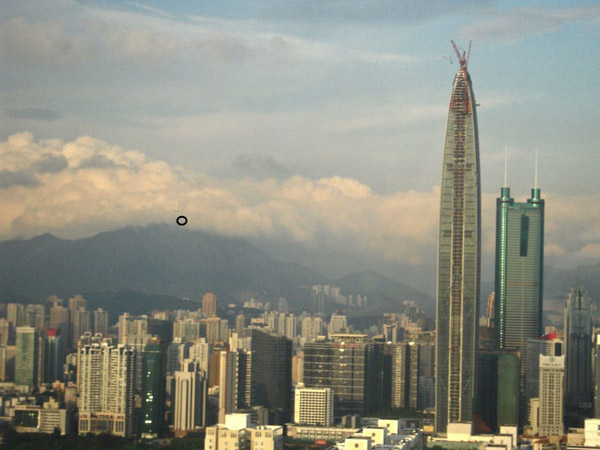
View from the Saige Plaza, Futian District, Shenzhen. The circle marks the location of the mobile phone factory. (Photo by author, 2011)
Factory life
Cong Hua Yun agreed to my visit to his factory and also invited me over for dinner to get the full experience of factory life. Unfortunately the appointment was in the evening when most of the workers already returned to their dorms. Maybe Cong Hua Yun planned it this way so that his workers wouldn’t be distracted by my presence. Packed with my camera and accompanied by people I met in Shenzhen who are friends of Cong Hua Yun we drove up the mountain. When arriving in the factory canteen the cook was asked to separately make a few dishes for us as most of the workers had already eaten. Steamed fish, spicy chicken, you cai (literally oil vegetables) and stir-fried mushrooms with roots were served with white rice. On the wall I noticed shelves that held everyone’s personal bowl and pair of chopsticks in happy colors. There was also a little corner shop that sold alcoholic and non-alcoholic beverages, snacks, instant noodles and basic daily products. I learned that the factory had around 80 workers at the moment, both male and female ranging from age 20 to 25. The factory used to have up to 120 workers but due to the bad business climate Cong Hua Yun had to let some of them go because there was no work. The workers earned around 2000 RMB a month, including three meals per day and dorm room. The work week lasts from Monday until Saturday and aside from Sunday’s the workers also get national holidays off. Cong Hua Yun explained that the current business climate for mobile phones wasn’t very good due to the fierce competition from larger factories as well as sole proprietors. As we sat down at the dinner table a bottle of Baijiu, a national distilled liquor usually made from sorghum, was immediately opened. I was introduced as an overseas student with a passion for electronics and curious about the making of a mobile phone. The meeting was set up quite informally by my guide Chen Shui who knew Cong Hua Yun from back in the days when he had just started as an entrepreneur in Shenzhen. Cong Hua Yun himself was very friendly but didn’t pay much attention to my presence as he and Chen Shui were downing the bottle of Baijiu as old friends that hadn’t spoken to each other in a long time. The factory also had a Labrador that had just given birth to four puppies and Cong Hua Yun mostly talked to me about the dogs. I’m not sure how serious he took my visit, as I never explained I was actually working on a research project, but maybe it was for the better. He probably wouldn’t have been so friendly and open if he had known I would report on the visit. After a tasty dinner one of the workers was called down to take me on a tour of the building.
The guy was aged 23 and very friendly. He showed me around the different spaces in the factory allowing me to take pictures. There were still a handful of workers busy with finishing the daily routine. First he showed the manufacturing hall with long rows of tables, wooden chairs and fluorescent tubes. All kinds of hardware parts were lying around from the smallest screws to displays and batteries. The available tools were mainly screwdrivers, soldering irons and a few old computers to program software. Next came the stockroom where all the different parts were neatly sorted and divided into boxes, including instruction booklets and packaging material. Although the building was a little smelly inside it didn’t look too dirty.I was told that the floor was swept and mopped everyday to provide a hygienic working and living environment. I asked if it was also possible to take a look inside the dorms and the guy took me down one level to show me their living conditions. Guys and girls had separate rooms on the same floor. The hallway was full of hanging laundry and on the floors there were food wrappers and empty bottles lying around. My guide apologized for the messiness and asked me if he should let the workers tidy their rooms before I took a picture. I told him this wasn’t necessary because I wanted to get an idea of how the workers really lived. The dorms were small and contained five bunk beds allowing maximum ten people. Most of the dorms had 9 people living in them, leaving 1 bed as storage space. In the middle of the row of beds was a walkway. Some of the girls’ rooms were decorated with colorful posters of famous people I didn’t recognize and a few girls were watching a movie on a laptop. The male dorms were pretty plain and stuffed with dirty laundry. I caught one girl lying in bed with a guy in the room, and when she saw me she giggled shyly and disappeared under the blanket.
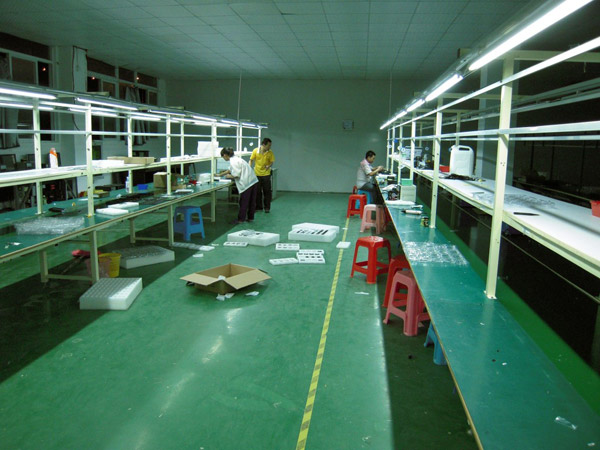 The factory hall after work hours. A few workers are finishing up the last phones of the day. (Photo by author, 2011)
The factory hall after work hours. A few workers are finishing up the last phones of the day. (Photo by author, 2011)
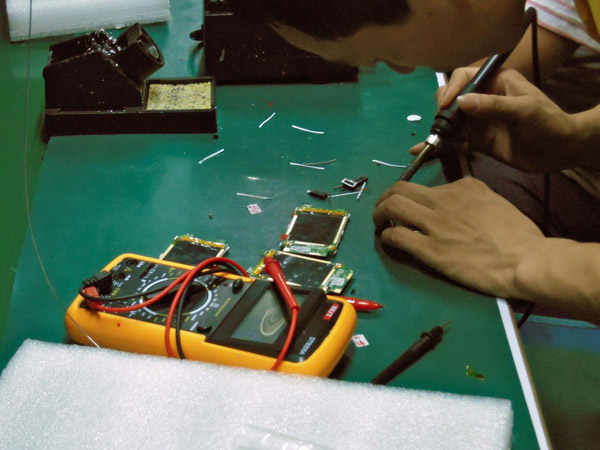
Manually connecting parts with a soldering iron and assembling the mobile phone (Photo by author, 2011)

Factory workers at the dorm after work hours watching a movie on a laptop. (Photo by author, 2011)
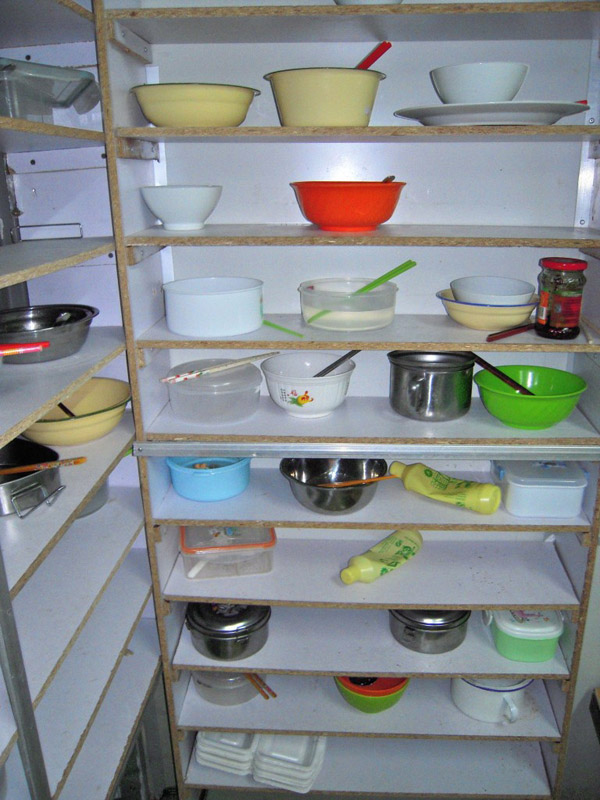
All the factory workers have their own bowl and chopsticks in the cafeteria (Photo by author, 2011)
Shanzhai
As I inspected the mobile phones that were almost finished I saw the brands were Motorola and Nokia. After taking a closer look I realized that these were Shanzhai phones, rip-offs named with a slight misspelling of the original brand, such as Motoloba and Nokla. Shenzhen is infamous for these kinds of electronics and the term Shanzhai is used for these fake versions of international brands. According to Xiandai Hanyu Dictionary Shanzhai can mean two things: a fenced place in the forest, or villages in the mountain that have stockade houses. Historically it was sometimes used to describe bandits who oppose and evade the authority to perform deeds the see as justified. The use of the term for imitation products comes from Cantonese slang in which ‘shanzhai factory’ means an ill-equipped, low-end factory. Nowadays, although a large portion of Shanzhai factories doesn’t deliver poor-quality products anymore they still carry a fake brand and the bad reputation. A reason to go Shanzhai is to bypass the government’s difficult regulations concerning becoming an official cell phone manufacturer. Companies try to operate under the radar to avoid the hassle. Gradually ‘Shenzhen products’ became ‘Shanzhai products’ because it sounds the same when people speak Mandarin with a Cantonese accent. Although manufacturing Shanzhai products is not legal the government tends to burn a blind eye because it helps develop the economy. This does not mean that there are no inspections. This is why these kinds of business don’t operate too openly.
The popularity of Shanzhai phones comes from the demand of the underserved markets in rural areas and smaller cities. Entrepreneurs answered to this demand by starting small factories with relatively little capital pursuing low prices and fast market response. The Taiwanese chip designer MediaTek has played a big role in facilitating the development of the sector offering good functionality, low prices and local technical support. With MediaTek taking over the chip design process Shanzhai factories could focus more attention on assembling mobile phones fit for consumers’ demand. Many factories bypass the network access license required for all new handsets according to the telecommunication standards to keep the prices low and speed of production and introduction high. For the same reasons manufacturers have also bypassed the obligation of equipping phones with a unique International Mobile Equipment Identity number. Both of the regulatory requirements are pricey and take up to six months of administrative effort and testing time.3 Sheng Zhu and Yongjiang Shi, both scholars from the Institute for Manufacturing at Cambridge University, argue that Shanzhai could be seen as evidence that China’s capabilities are developing and the industrial sector in the country is becoming increasingly sophisticated.
Now mobile phone developers have adopted Shanzhai as an ethos for manufacturing (…) many Shanzhai developers along the mobile phone supply chain have begun to reap the benefits by developing their own product designs and production capabilities. In this new version of Shanzhai the traditional concept of autonomy has taken the form of a degree of commercial independence. The Shanzhai idea of rebellion has evolved into a desire to take on global corporations by producing copies of world-leading mobile brands.4
The interesting part about their argument is that the rip-off products here can be seen as innovation. This new type of alternative innovation transforms unaffordable luxury goods in to affordable products for consumers with average wages. Shanzhai manufacturing might be a possible alternative innovation paradigm in some sectors in China. The industry can also offer instructive insight into operating in the local markets, which could be particularly useful in the context of China’s sometime unusual operating environment.5 Even though Shanzhai manufacturers don’t operate under proper licenses they have overcome their underground status and can be taken seriously as an industry. The phenomenon goes far beyond the simplistic view of rip-off products and describes a vendor who operates in a business without observing traditional rules or practices. This often results in innovative and unusual products or business models. The website shanzhai.com provides news and reviews on this tech-culture from China and reports on the developments of the peculiar market chain. It is still a challenge to buy the products that arise from this industry if you are located outside of China. There are issues with many smaller Chinese companies being unable to provide international support, accept payments into China or deliver small quantities. The best place to buy these products is Huaqiangbei Electronics Market in Shenzhen, there I’ve seen everything from the finest imitations to the oddest electronic mash-ups.
Brand new Motoloba’s ready to be packaged and distributed. (Photo by author, 2011)
Climbing the ladder
Chen Shui, who is an entrepreneur in Shenzhen himself, recently started his own Shanzhai mobile phone company and explained the ins and outs of this market branch.
The process of manufacturing a Shanzhai device starts with the choosing a design of the mobile phone from an image. This is already a difficult job because you have to know what sells and what models fit consumer taste. After picking the model molds have to be made for the production together with a dummy version that only shows the outside appearance. This takes about a week. Then you bring the molds and specifications to a factory to find out if it’s possible to fit all of your requirements into the device you designed. The essential question is: can it be made? This can take up to 20 days. Because all of these tasks are outsourced a recurring issue is price negotiation: it is hard to agree on a good price because everyone wants to make as much money as they can. If the production price is settled the contracting party must first use his own investment money to pay for the parts and the production costs up front. First a small amount is ordered, around 500 devices, and if there are no defects found a larger number can be ordered. The total process from picking the design to receiving the end products takes about two months. I visited Chen Shui at his office, which at the time was still a work in progress. While one guy responsible for delivering and putting together a large bookcase worked with drill and hammer three others were trying to work behind their desk in the middle of the noise. From my perspective the location and decoration of the office seemed a little bit over the top as Chen Shui had just started in the Shanzhai phone business and hadn’t made any money yet. He explained it was important to have a good-looking physical location to operate from, so clients and also manufacturers would take him more seriously. He invested a part of his starting capital in renting an office in the Saige Plaza, Futian District in the center of Shenzhen, and red wooden furniture. When the bookcase was properly assembled and put in place the empty shelves were gazing at us. He joked that he had never even finished high school and now had all these shelves to fill. As a present I gave him my copy of the English novel “Shanghai Girls” as his first book in the office. He thanked me and said, “Even though I can’t read it, an English book in my collection will make me look smart.”
I noticed that drinking Baijiu is important in making business deals as Chen Shui enthusiastically told me that he had just sealed the deal with a manufacturer and managed to knock off a few percent of the production price by downing half a liter of Baijiu on the spot. Being in the Shanzhai business is all about speed, making the length of production time as short as possible. Where the international brands are focused on quality and service, Shanzhai is about selling as many devices as possible before the model goes out of fashion. Most of these devices can’t be used outside of China because they can only operate on the Chinese network. A large proportion of the Shanzhai phones are sold in less developed cities because the people there do not have the money to purchase international brands. It is hard to pinpoint which mobile phone will become successful because the popularity of features and appearance can vary per region or city. But overall it can be said that rural areas like devices with a high volume, good reception, bright screens and long battery life. It is hard to make good money from Shanzhai phones. Chen Shui shared that on average he makes 8 RMB profit per device, which seems like little money for all the hassle and uncertainties of the business. He explained the appeal of Shenzhen to young people who are prepared to work hard to make money fast. Because the city has so much vigor in electronics it is appealing to migrants from other parts of China to partake in this opportunity. It wasn’t always his dream to start his own business in electronics but he told me it is better to follow the money rather than a childhood dream. Only ten years ago he was released from prison, where he was held for refusing to fulfill his military service. Visibly proud he said: “This is China, within ten years you can go from having nothing to staring your own business here where it all happens.”
Street vendors
Not only does Shenzhen have a big manufacturing and production industry in mobile phones, there are also countless places to buy the end products that result from all the hard work. The busy shopping areas all had guys sitting on the sidewalk equipped with a simple wooden desk and chair selling the newest and oldest mobile phones. Some of these street vendors decorated their spot with colorful paper displaying their best offers. Others had flashing gadgets to draw attention to their stands. Realistic as these businesses are, they spread their revenue flow by not only selling devices but also extra services. For up to 30 RMB you could get your mobile phone cleaned, inside out and a cheap protection film stuck over your expensive touch screen. From the speed these guys were working at it is safe to say they have quite a few customers a day. I tried sticking a protection film on an iPhone myself once and I ended up with three destroyed films and a naked iPhone, but I suppose practice makes perfect. As much as people claim that in China people will always try to take advantage of you to make money this little niche branch is quite honest with the services they offer. I renewed my iPhone protection film quite a few times during my trip, sometimes just to chat with the people, and it was not uncommon that the first vendor I went to made a deal and then called someone else down to do the job. If there wasn’t anyone to call they would ask around at their neighboring businesses if anyone had experience in renewing an iPhone protection film. Apparently there were only a few good ones for fancy phones in every area and most of the vendors would let that business go to them fearing they would stick the film on crooked and full of bubbles themselves. The profit would just be handed over without even as much as a sigh.
The second type of street vendors is more mobile. They carry around bags with stock and just run after their potential customers. Especially walking out of an electronics shop will have you surrounded with a couple of these vendors in no time. They just hold up a mobile phone and say ‘shou ji, shou ji’, meaning mobile phone, mobile phone. Most of them don’t really act convincing and if you show no interest after five steps they will leave you alone. The funniest thing to me was that the fronts of the Apple stores were swarming with guys selling iPhones and iPads. All official Apple stores had security guards standing on their doorstep and half a meter away were the non-official resellers intercepting the disappointed customers. At that time, mid 2011, it could be hard to lay your hands on the newest Apple products. A trip to the store didn’t do the job, as you first had to order the products online within a certain time of day and wait a few weeks before you could pick up your order at the Apple store. With the exception of America, Hong Kong and customers from a few other countries, it could be beneficial to buy your Apple products in China because of the price difference. Herefore some of these street vendors had quite some business. At my hostel in Beijing I spoke to an Australian guy that had bought a, what he believed to be, an iPhone 4 on the street for a good price. But after the purchase, when the salesman had enough time to get away, he found he had just paid for an overpriced empty iPhone 4 case.
Second handed
During my stay in Shenzhen I spent most of my time with a few local migrant workers in the second hand mobile phone industry. The couple Yu Feng and Guo Li Jiun are old friends of my brother who moved to Shenzhen nine years ago because of the good business climate in the Special Economic Zone. They both started in the second hand mobile phone industry as small-scale resellers. Aside from the flashy electronics Shenzhen has to offer there is also a market for second hand phones of models that have gone out of fashion in the Western world. As Shenzhen is only a subway ride away from Hong Kong, a mobile phone paradise because there is no tax on electronics,6 it was an easy decision to do something with the beneficial geography and regulations. Yu Feng made a trip to Hong Kong every week and handled the purchase of the devices. In December 2010 an article appeared in Guangzhou Daily describing the smuggling of Apple products into China with a total value of 950.000 RMB.7 Fourteen housewives carrying iPads, iPhones, and other electronics were caught at the Hong Kong–Shenzhen border. One of them had 65 mobile phones strapped to her body and another 20 in her handbag. The difference in pricing was seen as the main reason for this action. Another reason was that iPads sold in China didn’t used to have 3G. This electronics smuggling trend is widely exploited since most of the people selling fancy devices in Shenzhen without license perform this method. Yu Feng also performs this method incidentally, but only with the newest technology that is worth the risk and on a much smaller scale. For larger quantities he does shipments with the help of business associates. When the stock arrives his wife Guo Li Jiun takes the devices to the second hand mobile market and tries to sell them for a profit.
Zhou Han Si, the girl that I stayed with in Shenzhen, is a close friend of the couple and also works in the same business. Her house was a forty square meter apartment where all sorts of parts of mobile phones were stored. From screens and cases to indefinable pieces of wire and chips that were sorted in boxes and bags. She first spent over half an hour clearing a bed before I could lay my head down for a rest. She explained there wasn’t much storage room at the market and she also didn’t wanted to leave too many valuables there. Zhou Han Si and Guo Li Jiun took me to their work place, a five storey building in the Futian district named Chong Tian Di mobile phone market. It is a big musty building where every bit of space is used efficiently. On every floor little booths are rented out to vendors to sell their second hand mobile phones. Here you can find any type of mobile phone, also models that are no longer manufactured, as well as different parts to repair or assemble a mobile phone. Other electronics such as tablets and laptops are also sold but the main sales wares are mobile phones, loose parts and accessories. Zhou Han Si’s booth was a 1,5 meter wide glass display with just enough space to sit behind. A safe, calculator, rubber bands, writing material and some small tools was all the equipment she needed for work. Like her there were countless people crammed in a couple of hundred square meters all trying to make some money. The atmosphere was good, as most of the sales people had gotten to know each other quite well over time. The pungent smell of instant noodles and spicy food filled the aisles. Everyday there were a few empty booths as people didn’t show up or were on holiday. “That’s the good thing of being your own boss” Zhou Han Si explained with a smile. Usually she went to work six days a week, but because I was visiting and the market hadn’t been that profitable lately she came in less regularly. Days could go by without a sale, even though there always seemed to be customers around. It is hard to make a good deal as many of the customers are wholesales themselves. They are very picky on the models one has to offer and they are mainly interested in buying a large quantity of devices for a rock bottom price. The funny thing is that both customers as resellers have grown a technical set of skills in this industry. If a customer is interested in a certain device he will take the whole phone apart inspecting every little detail. I’ve never seen so many expensive phones being screwed open. Whenever there is a flaw detected the sales person would have to bring their knowledge to the table, reassuring the customer that the flaw is nothing problematic.
As Cong Hua Yun already mentioned the mobile phone business in general didn’t really flourish in 2011 in the Shenzhen area. The diversified devices and the fierce competition had caused prices to drop. This is the problem that the second hand mobile phone industry is also dealing with. Zhou Han Si bought a stock of second hand Nokia 6210 for about 600 RMB per device but due to the price drop she sold them for 350 RMB. She has suffered big losses this year and once she has gotten rid of all the Nokia’s she will withdraw from this industry and Shenzhen, moving back north to try and make a living in the gambling business with her boyfriend. Yu Feng and Guo Li Jiun are also lying low this year, not willing to risk their investment money in devices they can’t sell for a decent price. Aside from a few small units and smart phones on request they haven’t sold many devices this year. As their son turns 8 next year, Guo Li Jiun is thinking about moving back to her home town to be with her family after almost a decade of maternal absence. For the money making part she mentioned the red wine business that could be interesting to look into.
The sales of second-hand mobile phones by individuals is not fully legal practice in China. Because the vendors don’t have a license the government misses out on tax. Although this was loosely tolerated for a long time, recently there has been some effort from the police attempting to dismantle businesses that are trying to make black money. The devices sold by Zhou Han Si all come from Europe; old fashioned and second-hand devices are shipped to Hong Kong and sold to distributers in China or other Asian countries all through unofficial distribution routes. In my first week in Shenzhen there was a big police checkup at the Chong Tiandi mobile market. Most of the sales people just packed their valuables in a matter of seconds and left the building. Guo Li Jiun and Zhou Han Si didn’t dare to go to work for a whole week. The people in this business form an actual community in Shenzhen as they all tend to live in the same flat buildings, and I was staying in one of them. In the third week the police were taking it up a notch by also performing house searches. Because there isn’t much of storage room at the market most people keep their stock at home. Usually the building janitor lets the police in and warns a couple of residents that there are checkups. In a matter of minutes the whole building is informed and all the front doors are closed and locked. The knocks on the door are answered by turning down the volume of the TV and simply ignoring the rest. I was quite nervous because I didn’t wanted to get in any kind of trouble as a foreigner but Zhou Han Si reassured me that nothing would happen if we would keep the door shut. After two hours of waiting the police left and we opened the front door, bringing back the airflow that made the stuffy apartment comfortable again.

View from the 69th floor of the Diwang Mansion, Shenzhen. The river forms the border between Shenzhen and Hong Kong. (Photo by author, 2011)
1. Wanda Guo and Yueqiu Feng. “Special Economic Zones and Competitiveness, A Case Study of Shenzhen, the Peopleʼs Republic of China.” The PRM Policy Note 2007
2. MakeITfair. “Silenced to Deliver : Mobile phone manufacturing in China and the Philippines.” 2008
3. Hua Lee et al. “Shanzhai (‘Bandit’) Mobile Phone Companies: The Guerilla Warfare of Product Development and Supply Chain Management.” (Harvard: Business Publishing, 2010)
4. Sheng Zhu and Yongjiang Shi. “Shanzhai manufacturing – an alternative innovation phenomenon in China: Its value chain and implications for Chinese science and technology policies.” Journal of Science and Technology Policy in China 1.1, 2010: 46
5. John Rediehs et al. “Shanzhai (‘ Bandit ’) Mobile Phone Companies : The Guerrilla Warfare of Product development and Supply Chain Management.” Chicago Consulting.20 July 2011 <http://chicagoconsulting.us/uploads/Shanzhai_Case_study_document.pdf>
6. “Hong Kong Shopping, Free Quotation, Online Shopping, Overseas Order Service.”2010, HKshop. 12 July 2011 <http://www.hkshop.com>
7. 余琴. “14师奶带88台iPad过关.” Guangzhou Daily 2010. 12 July 2011. <http://gzdaily.dayoo.com/html/2010-12/08/content_1208154.htm>


